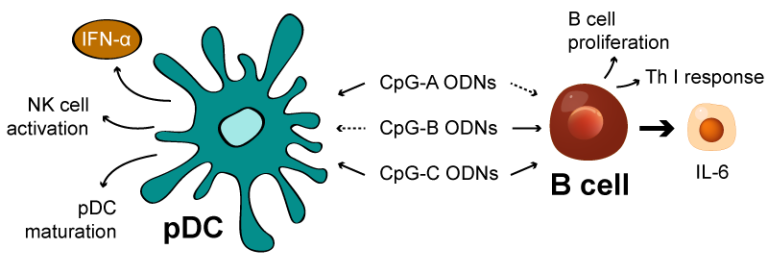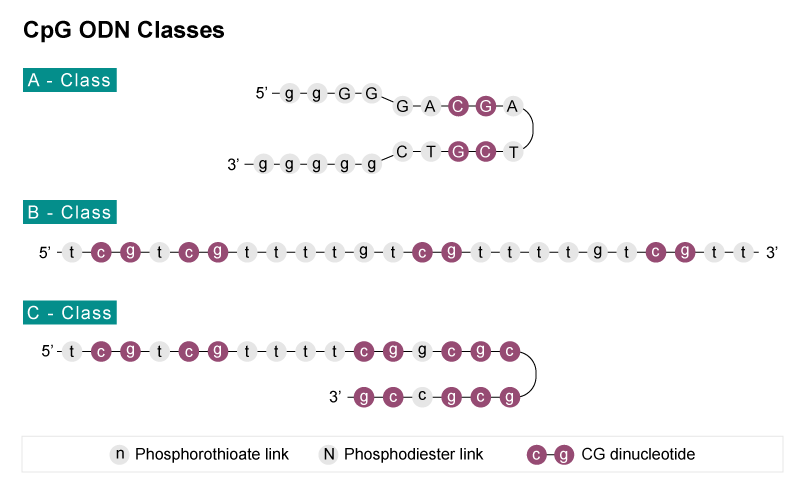Boosting Immune Response with CpG ODNs
Adjuvants are essential components in the field of vaccine research and preparation since they are immune enhancers that help boost the immune system’s response to a pathogen. One particular adjuvant, CpG ODNs, has garnered significant attention since 2000 due to its remarkable ability to enhance the immune system’s response. The use of CpG ODNs as adjuvants has been linked to more than 600 preclinical studies, demonstrating the immunogenicity of CpG-adjuvanted vaccines. These studies primarily focus on prophylactic and therapeutic vaccines for oncology, infectious diseases, and allergic diseases.
More than 20 adjuvanted CpG ODN vaccines are undergoing clinical studies, indicating the immense potential of this adjuvant in the field of medicine. The remarkable progress made in the study of CpG ODNs and their application in vaccines is paving the way for the development of innovative and effective vaccines, thereby providing hope for a better tomorrow.
Studies in the field of clinical medicine have indicated that CpG ODNs, short for oligodeoxynucleotides containing CpG motifs, can enhance the effectiveness of both humoral and cell-mediated responses against infectious diseases and cancer. Remarkably, this beneficial effect has also been observed in individuals with compromised immune systems.
In a major development for public health, Dynavax’s HEPLISAV-B vaccine was awarded FDA approval in November 2017. This innovative vaccine offers unparalleled protection against all known subtypes of the hepatitis B virus in adults aged 18 and over, thanks to its groundbreaking use of CpG adjuvants. What’s more, it represents a crucial breakthrough in the race to provide more accessible and effective hepatitis B vaccinations, offering patients the convenience of a two-dose immunization program.
It is clear that this remarkable achievement represents a huge step forward in the fight against hepatitis B, a devastating virus that has long caused untold suffering and resulted in millions of preventable deaths worldwide. We can only hope that this landmark moment will inspire further advancements in vaccine development, bringing us ever-closer to a future free from the burden of infectious disease.
What makes CpG ODNs so popular in vaccine adjuvants?
CpG Oligonucleotides (ODNs) are a type of synthetic DNA molecules that possess a unique sequence of cytosine-phosphate-guanine (CpG) sequences that are not methylated. These molecules have been extensively studied by scientists for their ability to stimulate Toll-like receptor 9 (TLR9) in both human plasmacytoid dendritic cells and B cells. This stimulation, in turn, initiates an innate immune response characterized by the production of Th1 and pro-inflammatory cytokines.
The key feature of CpG ODNs is their unmethylated CpG motifs that bind to TLR9 on the surface of immune cells, activating an immune response. This response is important in fighting infections and promoting immunity. Furthermore, CpG ODNs possess high immunostimulatory properties, making them ideal candidates for developing vaccines and immunotherapeutic agents.
CpG ODNs have been found to be an excellent replacement for bacterial DNA in activating B cells and plasmacytoid dendritic cells (pDCs). The result – induction of both innate and adaptive immune responses – is a key attribute that makes CpG ODNs relevant in various immunotherapeutic applications.
One of the primary mechanisms through which CpG ODNs operate is by acting as agonists of Toll-like receptor 9 (TLR9). Interestingly, CpG ODNs feature partial or complete phosphorothioate (PS) backbones that provide them with an added advantage over CpG DNA from lower organisms like bacteria. The PS modification protects CpG ODNs from nuclease degradation in vivo and also enhances their uptake by cells. This results in higher stability and longer half-life than CpG DNA from bacteria.
Furthermore, CpG ODNs have been found to improve the antigen-presentation function of dendritic cells (DCs), monocytes, and macrophages. They also induce B cell proliferation while indirectly boosting the immunoprotective activity of natural killer (NK) cells. Additionally, CpG ODNs are known to recruit T cells to the site of administration, further amplifying their immunostimulatory effects.

CpG ODNs have gained popularity as vaccine adjuvants due to their diverse effects on the immune system. These ODNs have the unique ability to induce faster, stronger, and longer-lasting humoral and cellular immune responses with higher affinity. This has made them a promising tool in the development of effective vaccines.
How to choose the type of CpG ODNs?
CpG ODNs, or short, single-stranded DNA molecules, present a great potential in terms of research applications, due to their unique immunomodulatory activities. These molecules can be synthesized with different structural features, making them flexible and versatile tools for a wide range of applications. There are three main types of CpG ODNs, which are classified based on their chemical structure and biological activity: Type A, Type B, and Type C. With each type presenting a specific set of characteristics, researchers are able to choose the most appropriate type for their specific needs. The diverse properties of CpG ODNs, coupled with their ease of synthesis, make them an attractive option for numerous scientific fields.

| CpG Type | Structural Feature | Immunomodulatory Activity |
|---|---|---|
| CpG-A ODNs |
Poly-G sequence at the 3ʹ and/or 5ʹ ends. A partially PS-modified backbone. GC dinucleotides contained within phosphodiester backbone. |
Strongly induce pDCs to secrete IFN-α. Promote APC maturation. Almost no effect on activation of B cells. |
| CpG-B ODNs |
A full PS linearized backbone. One or more CpG motifs. |
Strongly induce B cell proliferation and pDC maturation. Weakly induce pDCs to secrete IFN-α. |
| CpG-C ODNs |
A full PS backbone. CpG-containing palindromic motif. |
Strongly induce pDCs to secrete IFN-α. Induce the activation and proliferation of B cells. |
CpG ODNs are not only distinguished by their stimulatory activity, they also have species specificity. We summarized some information for your reference and informed CpG ODN selection, below.
CpG-A ODNs
| CpG Type | Species | Reference | Application |
|---|---|---|---|
| CPG ODN 1585 | Mouse | Most cited in literature |
Stimulating activation of mouse macrophages. RAW 264.7 cells NLRP3 to activate Priming. |
| CPG ODN 2216 | Human Preferred | Most cited in literature |
Stimulating pDC cells to produce IFN-α, TNF-α. Stimulating cells to produce IFN-α and IFN-γ by PBMC cells. |
|
CPG ODN 2336 |
Human Preferred | – | Inhibiting the secretion of IL-8 from HUVEC cells. |
CpG-B ODNs
| CpG Type | Species | Reference | Application |
|---|---|---|---|
| CPG ODN 1668 | Mouse | – | Column 4 Value |
| CPG ODN 1826 | Mouse | Column 3 Value 2 | Column 4 Value 2 |
| CPG ODN 2006/7909 | Human Preferred | Column 3 Value 3 | Column 4 Value 3 |
| CPG ODN 2007 | Bovine/Porcine | – | Column 4 Value 4 |
| CPG ODN BW006/ 684 | Human/Mouse | – | Column 4 Value 5 |
| CPG ODN D-SL01 | Multispecies | – | Column 4 Value 6 |
CpG-C ODNs
| CpG Type | Species | Reference | Application |
|---|---|---|---|
| Column 1 Value | Human / Mouse | Most cited in literature | Injecting mice as nanoadjuvant. |
| Column 1 Value 2 | Human / Mouse | – | Induction of matrix metalloproteinase 13-mediated invasion in human cancer cell lines. |
| Column 1 Value 3 | Multispecies | – | Stimulation of maturation and allogeneic activity of human bone marrow DCs. |
Why Choose Synbio Technologies?
At Synbio Technologies, we understand the crucial role that CpG ODNs play in research and we strive to provide the highest-quality products to meet our customers’ needs. Whether you require our pre-made spot products, or a custom sequence tailored to your specific research requirements, we have got you covered.
Our CpG ODN spot products are available in three types, each meeting the most stringent safety, quality, and efficacy standards. We pride ourselves on fast and efficient shipping, and all orders placed before our cut-off time can be shipped the same day.
For those needing a more customized solution, our team of scientists can synthesize tailor-made CpG ODN sequences with specific modifications to meet your unique research needs. We will work with you every step of the way to ensure that your order is delivered with maximum efficiency and accuracy.
Our products boast an impressive list of advantages, including large quantities of stock (1mg specifications), endotoxin content below 5EU/mg, and MS purity over 95%. Additionally, all of our CpG ODNs are free from harmful bacteria, ensuring that your research is not compromised.
If you’re looking to unleash the power of CpG ODNs in your next research project, look no further than Synbio Technologies. Our commitment to quality, safety, and efficacy, coupled with our unmatched expertise in CpG ODN synthesis, make us the ideal choice for researchers of all levels. Reach out to us today and let’s get started on your next big discovery!
Service Specifications
| Class | Name | Lot (#) | Species | Size/Tube |
|---|---|---|---|---|
| Class A | CpG ODN 1585 | SOC-A1585 | Mouse | 1 mg |
| Class A | CpG ODN 2216 | SOC-A2216 | Human Preferred | 1 mg |
| Class A | CpG ODN 2336 | SOC-A2336 | Human Preferred | 1 mg |
| Class B | CpG ODN 1668 | SOC-B1668 | Mouse | 1 mg |
| Class B | CpG ODN 1826 | SOC-B1826 | Mouse | 1 mg |
| Class B | CpG ODN 2006/7909 | SOC-B2006 | Human Preferred | 1 mg |
| Class B | CpG ODN 2007 | SOC-B2007 | Bovine / Porcine | 1 mg |
| Class B | CpG ODN BW006/684 | SOC-BW006 | Human & Mouse | 1 mg |
| Class B | CpG ODN D-SL01 | SOC-BDSL01 | Multispecies | 1 mg |
| Class C | CpG ODN 2395 | SOC-C2395 | Human / Mouse | 1 mg |
| Class C | CpG ODN M362 | SOC-CM362 | Human / Mouse | 1 mg |
| Class C | CpG ODN D-SL03 | SOC-CDSL03 | Multispecies | 1 mg |
 DNA Synthesis
DNA Synthesis Vector Selection
Vector Selection Molecular Biology
Molecular Biology Oligo Synthesis
Oligo Synthesis RNA Synthesis
RNA Synthesis Variant Libraries
Variant Libraries Genome KO Library
Genome KO Library Oligo Pools
Oligo Pools Virus Packaging
Virus Packaging Gene Editing
Gene Editing Protein Expression
Protein Expression Antibody Services
Antibody Services Peptide Services
Peptide Services DNA Data Storage
DNA Data Storage Standard Oligo
Standard Oligo Standard Genome KO Libraries
Standard Genome KO Libraries Standard Genome Editing Plasmid
Standard Genome Editing Plasmid ProXpress
ProXpress Protein Products
Protein Products
























